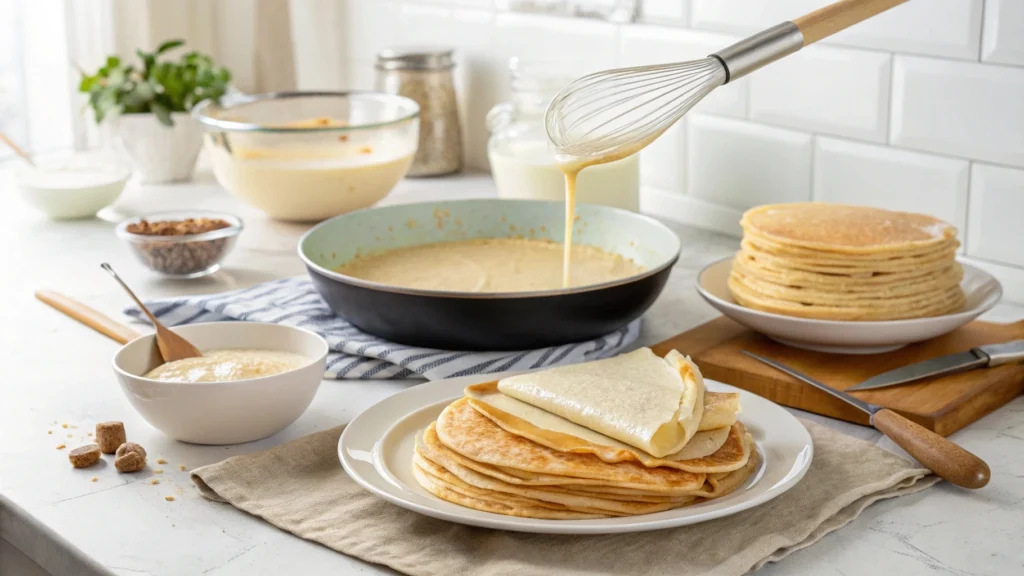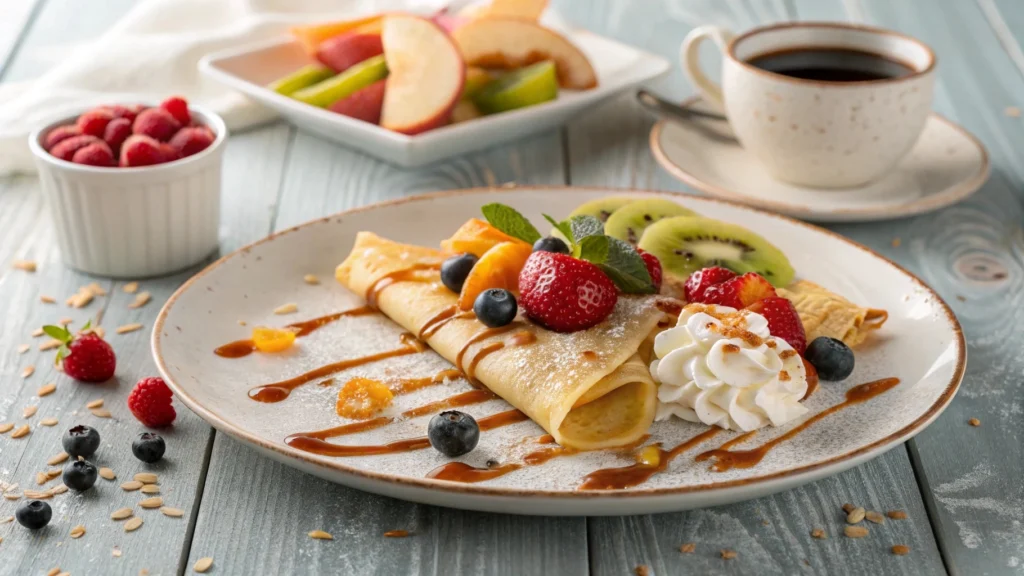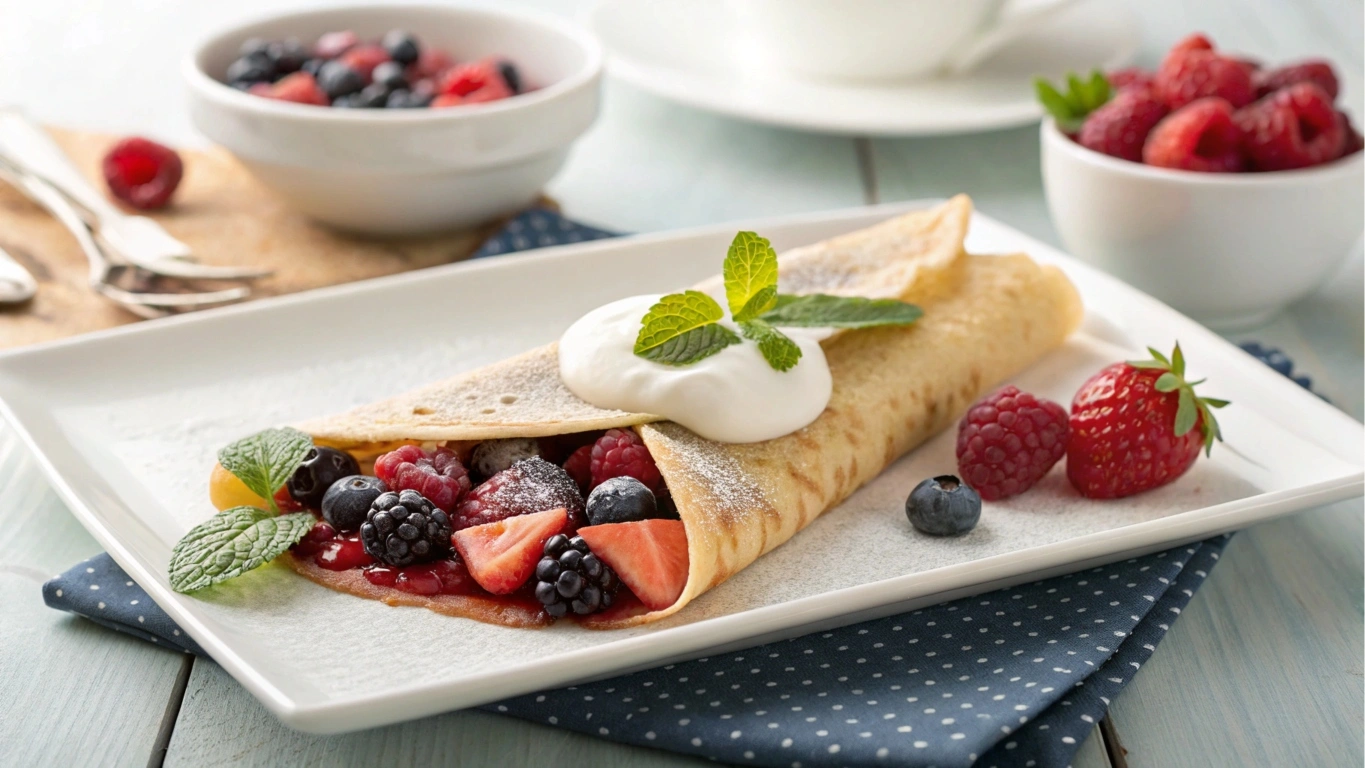Crepas, or crepes, are more than just thin pancakes – they’re a versatile culinary delight cherished worldwide. Whether you’re indulging in a sweet crepa topped with fruits and whipped cream or savoring a savory version filled with ham and cheese, these delicate creations offer endless possibilities. This article will explore everything you need to know about crepas, from their history and preparation techniques to exciting variations and serving tips. Let’s embark on this flavorful journey together!
Introduction
What Are Crepas?
also known as crêpes, are ultra-thin pancakes made from a simple batter of flour, eggs, milk, and butter. Originating in France, these delicacies are cooked on a flat surface to achieve their signature thin, slightly crispy texture. Unlike traditional pancakes, crepas are neutral in flavor, making them the perfect base for both sweet and savory creations.
A Brief History
The history of crepas dates back to 13th-century Brittany, France. Initially considered a staple food for the poor, they were made from buckwheat flour, which was inexpensive and readily available. Over time, crepas evolved into a culinary symbol of French sophistication, eventually spreading across the globe. Today, they’re celebrated on La Chandeleur (Candlemas), a French holiday where eating crepas is believed to bring prosperity.
Why Crepas Are Loved Worldwide
What makes crepas so universally adored? Their versatility! These tender, pliable treats can adapt to countless flavors and dietary needs. Whether filled with Nutella and bananas for breakfast or spinach and ricotta for dinner, crepas suit every meal and occasion. Plus, they’re quick and easy to make, ensuring they’re a favorite for home cooks and professional chefs alike.
Ingredients and Tools
Essential Ingredients
To make crepas that are perfectly thin and flavorful, you need just a handful of pantry staples: flour, eggs, milk, butter, and a pinch of salt. Each ingredient plays a critical role. Flour provides the base, while eggs give structure. Milk ensures a smooth consistency, and butter adds richness. For added flavor, you can include vanilla or a touch of sugar in the batter for sweet crepas.
Choosing the Right Flour and Dairy
The type of flour matters! All-purpose flour works well for most recipes, but for a more delicate texture, try cake flour. Similarly, while whole milk is ideal for its balance of creaminess, alternatives like almond or oat milk can be used for a dairy-free option. Experimenting with different combinations helps you craft crepas to suit any dietary preference.
Must-Have Tools for Crepa-Making
Creating flawless crepas doesn’t require a professional kitchen setup, but a few tools make the process easier. A flat, non-stick skillet or crepe pan is essential for achieving even cooking. A ladle ensures the right amount of batter is poured, while a crepe spreader helps distribute it evenly. Finally, a spatula allows for effortless flipping.
For more helpful tips on tools, check out this comprehensive guide on kitchen essentials.
Part 3: Step-by-Step Recipe for Basic Crepas

Preparing the Batter: Tips and Tricks
Start by whisking together the dry ingredients flour, sugar, and a pinch of salt in a large bowl. In a separate bowl, beat eggs and gradually add milk while whisking to avoid lumps. Combine the wet and dry ingredients, and mix until smooth. Let the batter rest for 30 minutes; this step is crucial to achieving silky-smooth crepas.
Mastering the Cooking Technique
Heat your crepe pan over medium heat and brush it lightly with butter. Pour a small amount of batter into the center and quickly tilt the pan in all directions to spread it thinly. Cook for about 1-2 minutes until the edges lift easily, then flip. Cook the other side briefly until golden. Remember, practice makes perfect!
Common Mistakes to Avoid When Making Crepas
Avoid overmixing the batter, as it can make crepas tough. Additionally, using too much batter results in thick, pancake-like crepas. Lastly, ensure your pan is evenly heated to prevent uneven cooking or sticking.
Delicious Crepa Variations
Savory Crepas: Fillings and Pairings
Savory crepas open up a world of delicious possibilities. Popular fillings include ham and cheese, spinach and ricotta, or smoked salmon with cream cheese. These options are perfect for brunch or a light dinner. Pair your savory crepas with a crisp green salad or a warm bowl of soup for a balanced meal.
For added variety, experiment with international flavors like taco-inspired fillings or a Mediterranean twist with hummus and roasted veggies. The beauty of crepas is their adaptability to any cuisine.
Sweet Crepas: Classic and Creative Toppings
For dessert lovers, sweet crepas are an irresistible treat. Classics like Nutella with bananas, strawberries with whipped cream, or powdered sugar with a squeeze of lemon are timeless choices. Want to get creative? Try caramelized apples with cinnamon, crushed pistachios with honey, or even a dollop of dulce de leche.
Sweet crepas are also great with ice cream or yogurt, transforming a simple dessert into a decadent experience.
Gluten-Free and Vegan Crepa Alternatives
For those with dietary restrictions, gluten-free and vegan crepas are easy to make. Swap regular flour with almond or rice flour and use plant-based milk like almond or soy milk. For vegan crepas, replace eggs with mashed bananas or a flaxseed-water mixture. These options don’t compromise on taste or texture, ensuring everyone can enjoy the magic of crepas.
Crepas in Different Cuisines

French Crêpes: The Original
The French take their crêpes seriously, and for good reason. Originating in Brittany, French crêpes are traditionally paired with cider and served as either a main course or dessert. Savory galettes, made with buckwheat flour, are often stuffed with hearty fillings like ham, eggs, and cheese. Sweet crêpes, on the other hand, are celebrated for their delicate flavors and simple toppings like sugar or jam.
Mexican Crepas: Unique Twists
In Mexico, crepas have found a special place in the culinary landscape. A popular variation is crepas de cajeta, thin pancakes drenched in rich caramel sauce made from goat’s milk. Another classic is crepas poblanas, filled with chicken and smothered in a creamy poblano pepper sauce. These unique twists showcase how different cultures adapt crepas to local ingredients and flavors.
Global Variations and Their Influences
Across the globe, crepas take on many forms. In Sweden, thin pancakes called pannkakor are often served with lingonberry jam. In Japan, Harajuku-style crepes are rolled into cones and packed with everything from fresh fruit to cheesecake slices. Whether sweet or savory, crepas prove to be a universal canvas for culinary creativity.
For more global recipe inspiration, check out this guide to international variations.
Tips for Serving and Storing Crepas
Keeping Crepas Warm for Serving
One of the challenges with crepas is keeping them warm and pliable, especially when preparing large batches. To retain their texture and warmth, stack cooked crepas on a plate and cover them with a clean kitchen towel. Alternatively, place the plate over a pot of simmering water to keep them warm using gentle steam. This method ensures your crepas stay soft and ready to serve.
For a buffet or gathering, consider using a warming tray or a low oven setting to maintain their ideal temperature.
Properly Storing Leftover Crepas
Storing leftover crepas is simple and convenient. Allow them to cool completely, then stack them with parchment paper between each layer to prevent sticking. Wrap the stack tightly in plastic wrap or place it in an airtight container. Store in the refrigerator for up to three days.
If you need to store them longer, crepas freeze exceptionally well. Simply follow the same steps and freeze for up to two months. Thaw them in the fridge overnight before reheating.
Reheating Techniques for Perfect Texture
Reheating crepas is quick and easy. Warm them in a non-stick skillet over medium heat for 30 seconds on each side, or microwave them for about 10-15 seconds. For larger batches, use an oven preheated to 300°F and wrap the crepas in foil to prevent drying out.
By following these tips, your crepas will taste just as fresh as when they were first made!
Frequently Asked Questions
How Do I Prevent My Crepas from Tearing?
To avoid tearing, ensure your batter is smooth and free of lumps. Letting the batter rest for at least 30 minutes allows the gluten to relax, resulting in more pliable crepas. Additionally, use a non-stick pan and avoid flipping too soon – wait until the edges lift easily.
What Is the Ideal Thickness for a Crepa?
The ideal crepa is paper-thin but sturdy enough to hold its fillings. To achieve this, use a ladle or measuring cup to pour a small amount of batter into the pan and swirl it quickly to spread evenly. Consistency is key, so adjust the amount of batter as needed for each crepa.
Can Crepas Be Frozen and Reused?
Yes! Crepas freeze wonderfully, making them a great make-ahead option. Stack cooled crepas with parchment paper between each, wrap them tightly, and store them in the freezer for up to two months. Reheat as needed for a quick and delicious meal or snack.
What Are the Best Substitutes for Milk in Crepa Recipes?
If you’re out of milk or need a dairy-free alternative, there are plenty of options. Almond, soy, oat, or coconut milk all work well in crepa recipes. For a unique flavor, try using buttermilk or even light cream diluted with water.
Health Benefits and Nutritional Value
Nutritional Profile
Crepas are simple yet nutrient-packed when made with wholesome ingredients. A standard crepa made with flour, eggs, milk, and butter provides carbohydrates for energy, proteins for muscle repair, and essential fats for brain health. Adding whole-grain flour or plant-based milk boosts the fiber and nutrient content, making crepas a healthier option.
For those watching their calorie intake, the thin nature of crepas makes them lighter compared to traditional pancakes. Additionally, they can be customized with low-fat or nutrient-rich fillings like fresh fruit, yogurt, or lean proteins.
Healthy Tips
To make your crepas even healthier, consider these tips:
- Use whole-grain or gluten-free flour: Adds fiber and makes them easier to digest.
- Switch to plant-based milk: Almond or oat milk works well and reduces fat.
- Limit added sugar: Sweeten naturally with fruit or a drizzle of honey.
- Incorporate vegetables: Spinach or grated zucchini blends into savory batters seamlessly.
By tweaking the recipe slightly, you can enjoy delicious crepas without compromising your health goals.
How Crepas Bring People Together
Crepas: A Meal for Any Occasion
One of the most charming aspects of crepas is how versatile they are for any meal or gathering. Whether served at a fancy brunch, as part of a casual dinner, or even as a midnight snack, crepas cater to everyone’s tastes. Sweet or savory, they’re perfect for celebrating special occasions or enjoying a quiet moment at home.
Creating Connections Through Crepa-Making
Making crepas can be a shared activity that brings people together. From preparing the batter to flipping and filling, the process is interactive and fun. Hosting a crepa party where guests can customize their fillings creates a relaxed and inclusive atmosphere.
Sharing recipes and exploring new flavors with friends and family makes crepas more than just a meal – they become a way to connect, celebrate, and create lasting memories.

